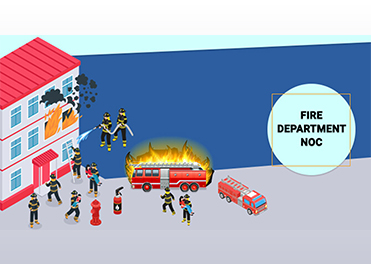Is Fire NOC Enough to Avoid Fire Accidents

Introduction
Fire accidents are a prevalent and devastating occurrence that can result in loss of life, property damage, and economic setbacks. To prevent such tragedies, fire departments issue Fire NOCs, or No Objection Certificates, as a regulatory requirement for buildings and establishments. However, despite the presence of Fire NOCs, fire accidents continue to happen. This article explores the effectiveness of Fire NOCs in preventing fire accidents and highlights the additional measures necessary to ensure robust fire safety.
Understanding Fire NOCs
Fire NOCs are certifications issued by the fire department after rigorous inspections to ensure that a building or establishment meets the required safety standards to prevent, control, and mitigate fire hazards. They assess various aspects, including the availability of fire extinguishers, fire alarms, proper exits, emergency lighting, evacuation plans, and adherence to building codes.
While Fire NOCs serve as a critical framework for fire safety and encourage compliance, they alone are not sufficient to eliminate fire accidents entirely.
The Limitations of Fire NOCs
1. Lack of Regular Inspections: Fire NOCs are typically issued for a specific duration, after which re-inspections are required to ensure continued compliance. However, inadequate follow-up inspections can lead to non-compliance or neglect in maintaining fire safety measures, increasing the risk of accidents.
2. Human Error: Despite the presence of fire safety measures, accidents can occur due to human negligence or ignorance of proper procedures. People may accidentally start fires or fail to respond effectively, rendering the Fire NOCs less effective in preventing incidents.
3. Obsolete Standards: Safety regulations and fire codes evolve with time to address new risks and challenges. Fire NOCs often rely on outdated standards, hindering their ability to effectively protect against the latest fire hazards.
4. Intentional Violations: Some building owners or occupants may deliberately violate fire safety measures to save costs or due to a lack of awareness about potential consequences. In such cases, Fire NOCs are insufficient to deter non-compliance.
A Multi-Faceted Approach to Fire Safety
For comprehensive fire safety, a multi-faceted approach is crucial. While Fire NOCs provide a foundation for fire safety, they must be complemented by additional measures to mitigate fire accidents effectively.
1. Regular Inspections: Inspections should be conducted periodically to ensure that safety measures are maintained and updated. Regular inspections bridge the gap between initial compliance and long-term safety, reducing the risk of incidents due to deteriorating fire safety measures.
2. Training and Awareness: Educating building occupants and employees about fire safety measures, evacuation plans, and appropriate response during emergencies is instrumental in preventing accidents. Training programs should be mandatory and regularly conducted to reinforce safety protocols.
3. Advanced Fire Detection Systems: Utilizing state-of-the-art fire detection systems enhances early detection, providing a better chance of controlling fires before they spread. Incorporating technologies like smoke detectors, thermal imaging cameras, and automatic alarm systems can significantly improve response times and save lives.
4. Proper Maintenance: Ensuring that fire safety equipment, such as fire extinguishers, sprinkler systems, and fire alarms, is functional and regularly maintained is vital. Neglected or faulty equipment can render Fire NOCs ineffective, compromising overall fire safety.
5. Public-Private Partnerships: Collaboration between government authorities, fire departments, and private entities is crucial for effective fire safety. Regular dialogues, mutual understanding, and joint initiatives can help address challenges and promote a culture of safety.
6. Continuous Improvement: Fire departments and regulatory bodies should regularly review and update fire safety standards and codes to keep pace with evolving risks. This ensures that Fire NOCs remain relevant and effective over time.
Conclusion
While Fire NOCs play a significant role in fire safety, they are not a panacea for preventing fire accidents. To ensure robust fire safety, it is essential to go beyond Fire NOCs and adopt a multi-faceted approach that includes regular inspections, training and awareness programs, advanced fire detection systems, proper maintenance, public-private partnerships, and continuous improvement. By acknowledging the limitations of Fire NOCs and taking these additional measures, we can minimize the occurrence and impact of fire accidents, safeguarding lives, property, and our communities.
- (This "Fire Safety Blogs" Published in March 2024 Edition)












